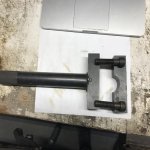I presume that the upper action shown with the barrel and trigger installed is a Vanguard? If so, this is what a Brownells receiver external wrench would look like:
View attachment 416575
The part shown with the half moon cut-out is actually sized for a Small Ring Mauser, and they also list it to fit a No. 1 or No. 4 Lee Enfield, with an additional plate used on the straight handle part, if you were to try to reproduce. A bar would be needed with a half moon cut out that closely fit your actions diameter.
Your lower receiver looks a lot like a Remington 700 - if so, the Brownell's wrench uses two half moon blocks - one above and one below, with a hole drilled through one to install an action screw to resist turning - also has a recess milled to hold a Remington style recoil lug.


















































